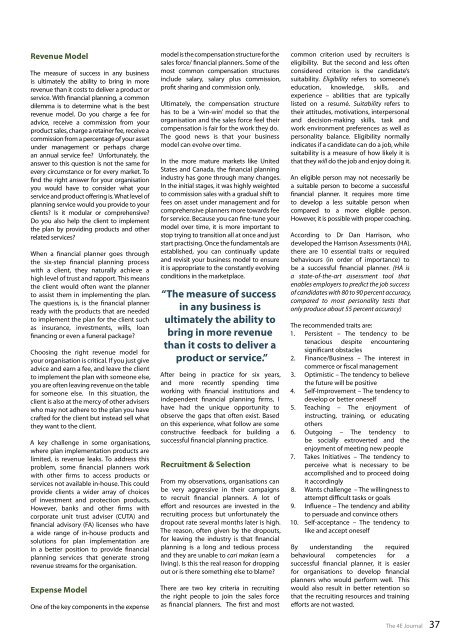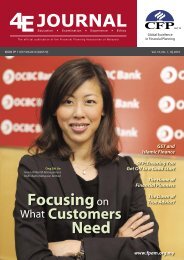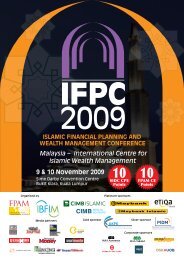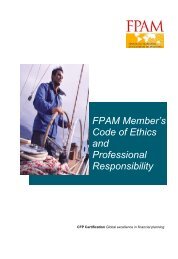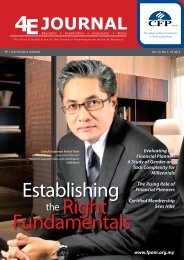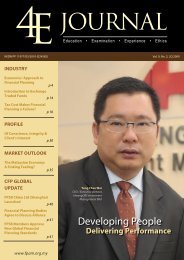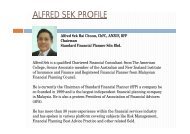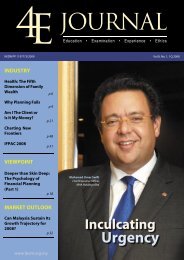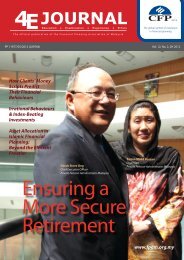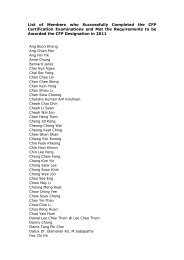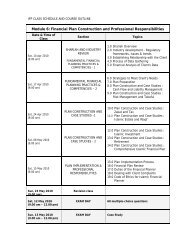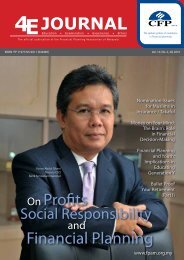Vol 10, No 4 - Financial Planning Association of Malaysia
Vol 10, No 4 - Financial Planning Association of Malaysia
Vol 10, No 4 - Financial Planning Association of Malaysia
Create successful ePaper yourself
Turn your PDF publications into a flip-book with our unique Google optimized e-Paper software.
Revenue Model<br />
The measure <strong>of</strong> success in any business<br />
is ultimately the ability to bring in more<br />
revenue than it costs to deliver a product or<br />
service. With financial planning, a common<br />
dilemma is to determine what is the best<br />
revenue model. Do you charge a fee for<br />
advice, receive a commission from your<br />
product sales, charge a retainer fee, receive a<br />
commission from a percentage <strong>of</strong> your asset<br />
under management or perhaps charge<br />
an annual service fee Unfortunately, the<br />
answer to this question is not the same for<br />
every circumstance or for every market. To<br />
find the right answer for your organisation<br />
you would have to consider what your<br />
service and product <strong>of</strong>fering is. What level <strong>of</strong><br />
planning service would you provide to your<br />
clients Is it modular or comprehensive<br />
Do you also help the client to implement<br />
the plan by providing products and other<br />
related services<br />
When a financial planner goes through<br />
the six-step financial planning process<br />
with a client, they naturally achieve a<br />
high level <strong>of</strong> trust and rapport. This means<br />
the client would <strong>of</strong>ten want the planner<br />
to assist them in implementing the plan.<br />
The questions is, is the financial planner<br />
ready with the products that are needed<br />
to implement the plan for the client such<br />
as insurance, investments, wills, loan<br />
financing or even a funeral package<br />
Choosing the right revenue model for<br />
your organisation is critical. If you just give<br />
advice and earn a fee, and leave the client<br />
to implement the plan with someone else,<br />
you are <strong>of</strong>ten leaving revenue on the table<br />
for someone else. In this situation, the<br />
client is also at the mercy <strong>of</strong> other advisers<br />
who may not adhere to the plan you have<br />
crafted for the client but instead sell what<br />
they want to the client.<br />
A key challenge in some organisations,<br />
where plan implementation products are<br />
limited, is revenue leaks. To address this<br />
problem, some financial planners work<br />
with other firms to access products or<br />
services not available in-house. This could<br />
provide clients a wider array <strong>of</strong> choices<br />
<strong>of</strong> investment and protection products.<br />
However, banks and other firms with<br />
corporate unit trust adviser (CUTA) and<br />
financial advisory (FA) licenses who have<br />
a wide range <strong>of</strong> in-house products and<br />
solutions for plan implementation are<br />
in a better position to provide financial<br />
planning services that generate strong<br />
revenue streams for the organisation.<br />
Expense Model<br />
One <strong>of</strong> the key components in the expense<br />
model is the compensation structure for the<br />
sales force/ financial planners. Some <strong>of</strong> the<br />
most common compensation structures<br />
include salary, salary plus commission,<br />
pr<strong>of</strong>it sharing and commission only.<br />
Ultimately, the compensation structure<br />
has to be a ‘win-win’ model so that the<br />
organisation and the sales force feel their<br />
compensation is fair for the work they do.<br />
The good news is that your business<br />
model can evolve over time.<br />
In the more mature markets like United<br />
States and Canada, the financial planning<br />
industry has gone through many changes.<br />
In the initial stages, it was highly weighted<br />
to commission sales with a gradual shift to<br />
fees on asset under management and for<br />
comprehensive planners more towards fee<br />
for service. Because you can fine-tune your<br />
model over time, it is more important to<br />
stop trying to transition all at once and just<br />
start practising. Once the fundamentals are<br />
established, you can continually update<br />
and revisit your business model to ensure<br />
it is appropriate to the constantly evolving<br />
conditions in the marketplace.<br />
“The measure <strong>of</strong> success<br />
in any business is<br />
ultimately the ability to<br />
bring in more revenue<br />
than it costs to deliver a<br />
product or service.”<br />
After being in practice for six years,<br />
and more recently spending time<br />
working with financial institutions and<br />
independent financial planning firms, I<br />
have had the unique opportunity to<br />
observe the gaps that <strong>of</strong>ten exist. Based<br />
on this experience, what follow are some<br />
constructive feedback for building a<br />
successful financial planning practice.<br />
Recruitment & Selection<br />
From my observations, organisations can<br />
be very aggressive in their campaigns<br />
to recruit financial planners. A lot <strong>of</strong><br />
effort and resources are invested in the<br />
recruiting process but unfortunately the<br />
dropout rate several months later is high.<br />
The reason, <strong>of</strong>ten given by the dropouts,<br />
for leaving the industry is that financial<br />
planning is a long and tedious process<br />
and they are unable to cari makan (earn a<br />
living). Is this the real reason for dropping<br />
out or is there something else to blame<br />
There are two key criteria in recruiting<br />
the right people to join the sales force<br />
as financial planners. The first and most<br />
common criterion used by recruiters is<br />
eligibility. But the second and less <strong>of</strong>ten<br />
considered criterion is the candidate’s<br />
suitability. Eligibility refers to someone’s<br />
education, knowledge, skills, and<br />
experience – abilities that are typically<br />
listed on a resumé. Suitability refers to<br />
their attitudes, motivations, interpersonal<br />
and decision-making skills, task and<br />
work environment preferences as well as<br />
personality balance. Eligibility normally<br />
indicates if a candidate can do a job, while<br />
suitability is a measure <strong>of</strong> how likely it is<br />
that they will do the job and enjoy doing it.<br />
An eligible person may not necessarily be<br />
a suitable person to become a successful<br />
financial planner. It requires more time<br />
to develop a less suitable person when<br />
compared to a more eligible person.<br />
However, it is possible with proper coaching.<br />
According to Dr Dan Harrison, who<br />
developed the Harrison Assessments (HA),<br />
there are <strong>10</strong> essential traits or required<br />
behaviours (in order <strong>of</strong> importance) to<br />
be a successful financial planner. (HA is<br />
a state-<strong>of</strong>-the-art assessment tool that<br />
enables employers to predict the job success<br />
<strong>of</strong> candidates with 80 to 90 percent accuracy,<br />
compared to most personality tests that<br />
only produce about 55 percent accuracy)<br />
The recommended traits are:<br />
1. Persistent – The tendency to be<br />
tenacious despite encountering<br />
significant obstacles<br />
2. Finance/Business – The interest in<br />
commerce or fiscal management<br />
3. Optimistic – The tendency to believe<br />
the future will be positive<br />
4. Self-Improvement – The tendency to<br />
develop or better oneself<br />
5. Teaching – The enjoyment <strong>of</strong><br />
instructing, training, or educating<br />
others<br />
6. Outgoing – The tendency to<br />
be socially extroverted and the<br />
enjoyment <strong>of</strong> meeting new people<br />
7. Takes Initiatives – The tendency to<br />
perceive what is necessary to be<br />
accomplished and to proceed doing<br />
it accordingly<br />
8. Wants challenge – The willingness to<br />
attempt difficult tasks or goals<br />
9. Influence – The tendency and ability<br />
to persuade and convince others<br />
<strong>10</strong>. Self-acceptance – The tendency to<br />
like and accept oneself<br />
By understanding the required<br />
behavioural competencies for a<br />
successful financial planner, it is easier<br />
for organisations to develop financial<br />
planners who would perform well. This<br />
would also result in better retention so<br />
that the recruiting resources and training<br />
efforts are not wasted.<br />
The 4E Journal 37


